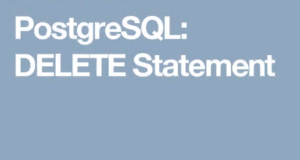REQUEST COMPLIMENTARY SQLS*PLUS LICENCE
PostgreSQL DELETE statement

The PostgreSQL DELETE statement is used to remove one or more records from a table in PostgreSQL.
DELETE statement syntax in PostgreSQL
DELETE FROM tab
[WHERE conds];
Parameters and arguments of the statement
tab – The table from which you want to remove the entries.
WHERE conds – Optional. The conditions that must be met to delete records. If there are no conditions are provided, all records from the table will be deleted.
Note:
- You do not need to enumerate fields in PostgreSQL statement DELETE, because you remove the whole row from the table.
An example statement with one condition
Consider a simple example where we have only one condition in the DELETE operator.
For example:
DELETE FROM contacts
WHERE first_name = 'Freya';
This PostgreSQL DELETE example will remove all records from the contacts table, where first_name equals ‘Freya’.
You can define the number of lines to be deleted by executing the following SELECT operator before deleting.
SELECT count(*)
FROM contacts
WHERE first_name = 'Freya';
An example of a statement with two conditions
Consider an example where we have only two conditions in a DELETE operator.
For example:
DELETE FROM contacts
WHERE first_name = 'Bony'
AND contact_id >= 400;
This PostgreSQL example DELETE will delete all records from the contacts table, where first_name has the value “Bony”, and the customer_id is greater than or equal to 400.
You can define the number of lines to be deleted by executing the following SELECT operator before deleting.
SELECT count(*)
FROM contacts
WHERE first_name = 'Bony'
AND contact_id >= 400;
Example using EXISTS condition
You can also perform more complex deletions.
You can delete records in one table based on the values in another table. Since you can’t list more than one table in the PostgreSQL FROM statement when you perform deletions, you can use the EXISTS sentence.
For example:
DELETE FROM suppls
WHERE EXISTS
( SELECT 1
FROM customers
WHERE customers.customer_id = suppliers.supplier_id
AND customer_id < 1000 );
This example will delete all entries in the supplier table that have an entry in the customer_id table that is less than 1000 and customer_id that corresponds to supplier_id.
You can define the number of rows to be deleted by calling the postgresql_info function or by executing the following SELECT statement before deleting.
SELECT COUNT(*) FROM suppls
WHERE EXISTS
( SELECT 1
FROM customers
WHERE customers.customer_id = suppls.suppl_id
AND customer_id < 1000 );
PostgreSQL: How to Delete Records | Course
MORE NEWS
PreambleNoSql is not a replacement for SQL databases but is a valid alternative for many situations where standard SQL is not the best approach for...
PreambleMongoDB Conditional operators specify a condition to which the value of the document field shall correspond.Comparison Query Operators $eq...
5 Database management trends impacting database administrationIn the realm of database management systems, moreover half (52%) of your competitors feel...
The data type is defined as the type of data that any column or variable can store in MS SQL Server. What is the data type? When you create any table or...
PreambleMS SQL Server is a client-server architecture. MS SQL Server process starts with the client application sending a query.SQL Server accepts,...
First the basics: what is the master/slave?One database server (“master”) responds and can do anything. A lot of other database servers store copies of all...
PreambleAtom Hopper (based on Apache Abdera) for those who may not know is an open-source project sponsored by Rackspace. Today we will figure out how to...
PreambleMongoDB recently introduced its new aggregation structure. This structure provides a simpler solution for calculating aggregated values rather...
FlexibilityOne of the most advertised features of MongoDB is its flexibility. Flexibility, however, is a double-edged sword. More flexibility means more...
PreambleSQLShell is a cross-platform command-line tool for SQL, similar to psql for PostgreSQL or MySQL command-line tool for MySQL.Why use it?If you...
PreambleWriting an application on top of the framework on top of the driver on top of the database is a bit like a game on the phone: you say “insert...
PreambleOracle Coherence is a distributed cache that is functionally comparable with Memcached. In addition to the basic function of the API cache, it...
PreambleIBM pureXML, a proprietary XML database built on a relational mechanism (designed for puns) that offers both relational ( SQL / XML ) and...
What is PostgreSQL array? In PostgreSQL we can define a column as an array of valid data types. The data type can be built-in, custom or enumerated....
PreambleIf you are a Linux sysadmin or developer, there comes a time when you need to manage an Oracle database that can work in your environment.In this...
PreambleStarting with Microsoft SQL Server 2008, by default, the group of local administrators is no longer added to SQL Server administrators during the...















